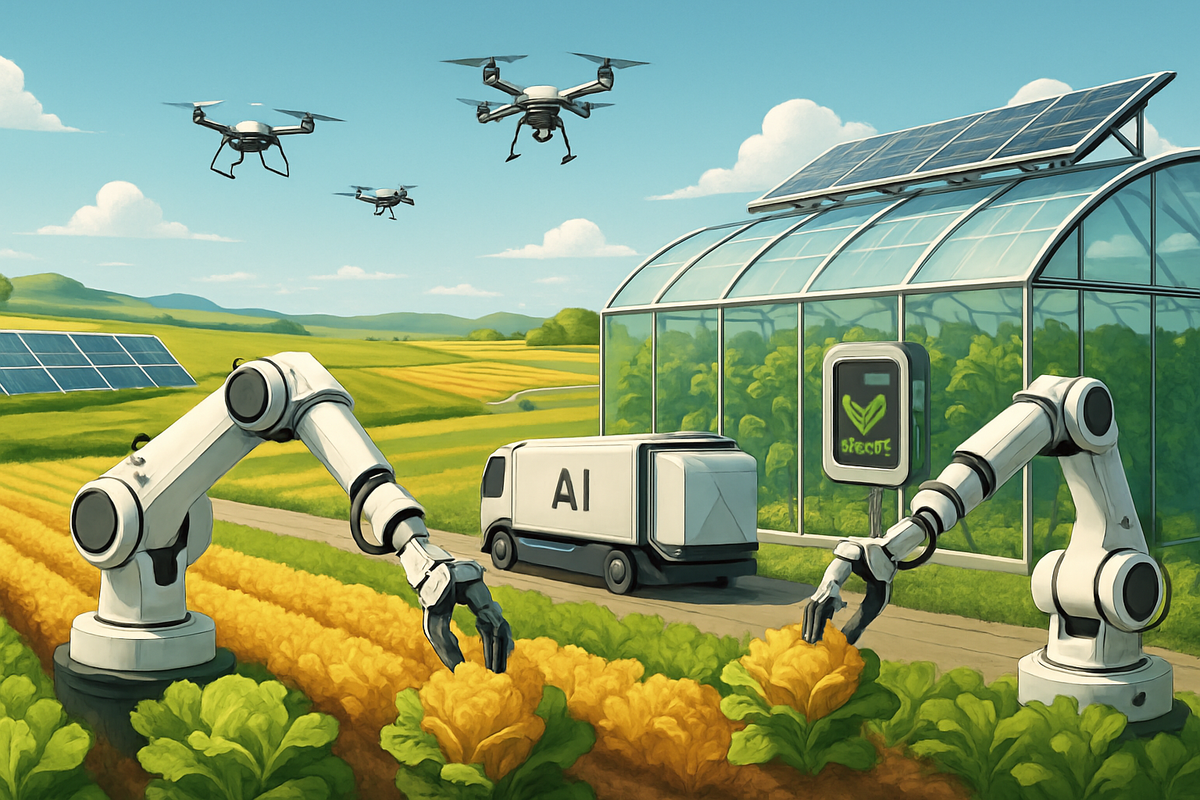The Farm of the Future: How AI-Powered Sensors and Robotics Are Revolutionizing Global Food Security
Discover how AI and robotics are revolutionizing agriculture, transforming farms into smart, sustainable powerhouses to meet the challenges of climate change and global food security. Is the future farm our answer to feeding a warming world?

Welcome to the Smart Farm: Where Algorithms Meet Agriculture
Forget the red barn and the pitchfork—today’s farm is more Silicon Valley than Old MacDonald. In 2025, AI-powered sensors, agile robotics, and data-driven supply chains are transforming how we grow, move, and consume food. As climate change, population booms, and resource scarcity threaten global food security, the world’s brightest minds (and biggest investors) are betting that smarter farms are our best hope for a sustainable, profitable, and resilient food future.
“AI isn’t just changing what’s on your plate—it’s rewriting the entire recipe for how your food is grown, shipped, and served.”
The High-Tech Harvest: What’s Actually Happening?
Let’s dig into the dirt—digitally, of course. Here’s how the latest agtech is reshaping global food production:
- Precision AI Sensors: BinSentry has raised $50 million to deploy solar-powered, AI-driven sensors that monitor animal feed bins across North America and Brazil. With 99% inventory accuracy, these sensors eliminate manual checks, prevent waste, and keep food supplies flowing even when the weather (or a pandemic) throws a curveball.
- Robotics with a Gentle Touch: Daimon Robotics just secured $13.9 million to build robots with fingertip sensitivity hundreds of times greater than a human’s. These bots are already at work in smart logistics and manufacturing, picking, sorting, and handling food with the care of a master chef (minus the hat).
- Bio-Inspired Innovation: Chinese researchers have developed robotic grippers inspired by seed pods, able to grasp and hold with minimal energy—ideal for delicate crops or aerial drone harvesting missions.
- Smart Supply Chains: AI-powered robots from Swedish firm Rebl are automating warehouses for giants like H&M and IKEA, proving that what works for t-shirts can work for tomatoes. Their neural-networked robots sort, stack, and move goods with uncanny efficiency, reducing waste and keeping shelves stocked.
Why Now? The Global Race for Food Resilience
It’s not just about shiny gadgets. The world’s biggest economies are in a high-stakes agtech sprint:
- China is investing billions in humanoid robotics, opening the world’s first robot mall, and fielding gold-medal-winning bots at the World Humanoid Robot Games.
- The U.S. and Europe are racing to weave AI into every link of the food chain—from field-level soil monitors to cloud-based logistics platforms.
- Africa is scaling up AI training for food security as part of Agenda 2063, recognizing that digital tools are as vital as tractors for the next agricultural revolution.
Why the urgency? Because the old ways simply won’t feed 9+ billion people on a warming planet. Precision, predictability, and resilience are no longer optional—they’re existential.
From Farm to Fork: How the Tech Translates
1. Precision Farming: More Data, Less Drama
AI sensors track everything from soil moisture to animal health in real time. Imagine a dairy cow with a Fitbit—except it actually tells you when she’s about to get sick, saving money and improving welfare. Drones scan fields for pests, robots deliver fertilizer only where needed, and harvests are timed to the minute for peak flavor and nutrition.
2. Animal Welfare Gets Smart
With biosensors and computer vision, farmers can spot disease outbreaks before they start, monitor stress in livestock, and even predict when a chicken is feeling under the weather. Happier animals, healthier food, fewer antibiotics. Win-win-win.
3. Supply Chain Superpowers
AI-powered logistics mean less spoilage and fewer empty supermarket shelves. Solar sensors like BinSentry’s eliminate guesswork in animal feed, while robotics in warehouses ensure fresh produce moves fast from farm to fork. In a world where one ship stuck in a canal can cause global panic, digital transparency is a superpower.
The Payoff: Sustainability, Profitability, and Security
- Sustainability: Targeted resource use slashes water, energy, and chemical waste. AI doesn’t just grow more food—it grows it smarter.
- Profitability: Automation cuts labor costs and losses from spoilage, while real-time data unlocks new markets and premium pricing.
- Security: Resilient, decentralized supply chains are less vulnerable to shocks—be it drought, disease, or a sudden craving for avocado toast.
"The farm of the future won’t just feed the world—it will heal it, connect it, and maybe even inspire a few TikTok dances along the way."
How to Get Involved (and Why You Should!)
Farmers: Explore AI-powered platforms and robotics to boost your yields and resilience. Many solutions, from John Deere Precision Ag to Microsoft Azure FarmBeats, are now accessible even to small operations.
Investors: Agtech is heating up. Look for startups blending sustainability with scalable AI—think sensors, supply chain software, or next-gen robotics.
Consumers: Support brands and grocers using smart supply chains and sustainable practices. The next time you bite into a perfectly ripe tomato, remember: there’s probably an algorithm somewhere cheering you on.
The Next Bite: Why the Story Isn’t Over
As the world’s population grows and the climate keeps us guessing, the fusion of AI, robotics, and advanced data analytics offers a buffet of hope—and a dash of healthy skepticism. Will robots write the next chapter of food security? Or will we need to teach them to appreciate the subtlety of a sun-warmed strawberry?
One thing’s certain: The farm of the future is already here. Are you ready to cultivate your curiosity?
Enjoyed this tasty tech tour? Become a Funaix Insider for free!
Subscribers get smart news, exclusive perks, and the chance to join our lively comment section (it’s like a digital farmer’s market—only with more AI jokes). Subscribing is free, for now!




